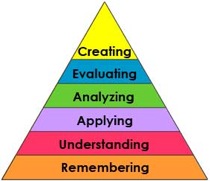Gauging Student Learning with Bloom’s Taxonomy
November 23, 2009
To begin detailed discussion about measuring student learning, we ought to consider one of the most critical tools to distinguish between superficial understandings, and complete comprehension.
Verbs.
They can run, jump, bounce, and fly, but, when applied to students, verbs do something very different.
Students sit. Students read. Students write. How much more do we ask students to do? When we measure student knowledge we seek to quantify the depth of understanding they have acquired. But limited or inaccurate verbs often curtail the degree to which we push students to develop a deeper understanding of their subject thereby undermining the e
fficacy of our instruction and diminishing a teachers personal satisfaction with their teaching.
Harold Bloom’s Taxonomy of Knowledge provides a quick and dirty system for separating types of knowledge by identifying terminology that differentiates elementary exposure from complex and multi-faceted understanding. While each form of knowledge is worth having, the degree to which we value one can unintentionally come at the expense of another.
The hierarchical structure of the taxonomy suggests that while these forms of knowledge are separate, they relate to and build upon one another. Thus using the taxonomy pictured below as a developmental guide in formative assessments can guide the construction of knowledge and encourage deep learning.

For example, a class can begin with a question that invites students to recall or define a concept from that day’s reading assignment (e.g. “What happened in the election of 1876?” or “What is osmosis?”). The next step will be to build upon that knowledge for a deeper understanding by applying the basic information to higher order skills (e.g. “illustrate the process of osmosis in these cells”) and then using your understanding to analyze the situation (“contrast the disputed election of Hayes to the 1824 election of John Quincy Adams”). This all attempts to reach a point where students construct their own personal methods of relating to the text and making critical evaluations (“evaluate the role Grant played in guiding (or failing to guide) the election”) or creating deeper meaning (“design a laboratory experiment to demonstrate the effects of osmosis”). But when a student sits, and reads, and writes test after test after test, if the questions never move beyond naming the candidates of a given election or matching the term to its definition, then all the discussion, all the effort, all the applying, analyzing, evaluating and creating seems pointless. All we have left is a few random memories, rather than complete knowledge of the subject.
In discussions, projects and final exams, the verbs we use to elicit answers can determine the degree to which students express their understanding. Implementing Bloom’s taxonomy in the construction of measurements can play a vital role in ensuring that students truly comprehend the concepts that educators feel matter most. Re-evaluating the ways we measure student learning does not necessarily require sweeping changes; careful consideration of assessment methods? can finish, accomplish, or simply do the job.
For more information regarding Bloom’s Taxonomy and Assessment, explore the following links:
http://www.odu.edu/educ/roverbau/Bloom/blooms_taxonomy.htmhttp://projects.coe.uga.edu/epltt/index.php?title=Bloom%27s_Taxonomy
Entry Filed under: Assessment,Learning Outcomes. Posted in Assessment ,Learning Outcomes .